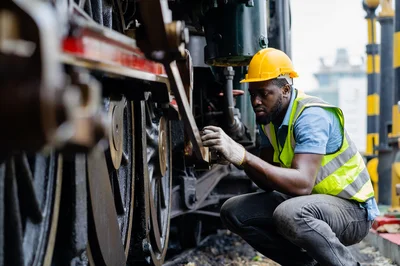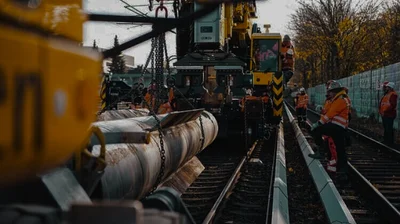
Railroad workers in Louisiana face a significant occupational risk for asbestos exposure. Asbestos, once hailed for its versatility and heat-resistant properties, has left a dark legacy in the railroad industry, posing serious health risks to Louisiana railroad workers and others who work on or around trains and railway infrastructure.
This page delves into the specific asbestos exposure risks faced by railroad workers in Louisiana and explores legal options for seeking compensation and justice.
The use of asbestos in locomotives dates back to the early 1900s when asbestos fibers were incorporated into various locomotive components for their heat-resistance and durability. This includes brake shoes and clutches, where asbestos was used to manage the high temperatures generated during operations.
Additionally, asbestos insulation was prevalent in boiler insulation and around steam pipes to retain heat and prevent burns. Gaskets containing asbestos were also common, ensuring tight seals in high-temperature and high-pressure environments. These components, essential to the functioning and safety of locomotives, frequently contained asbestos.
However, as the harmful effects of asbestos exposure became more widely known in the latter half of the 20th century, regulations and restrictions on the substance's use were implemented. This led to a gradual phase-out of asbestos in locomotives, with alternative materials being used instead.
Select a location where you or a household member worked to see the jobsites in that location with known asbestos exposure.
While asbestos was used in various components of the locomotives found in Louisiana, certain railroad jobs placed individuals at a higher risk of exposure than others. These included Louisiana railroad maintenance workers regularly handling and replacing asbestos-containing components, such as brake shoes and gaskets.
Louisiana railroad mechanics and engineers who worked with locomotive engines were also at a higher risk of exposure, as they would come into close contact with the insulation surrounding boilers and pipes.
Furthermore, train operators and conductors in Louisiana were exposed to asbestos through the air, as the fibers could become airborne during repairs and maintenance work on locomotives.
On the other hand, Louisiana railroad workers in administrative roles or those who worked primarily on passenger trains were at a lower risk of asbestos exposure. However, it is important to note that even these individuals were not completely immune to exposure, as they may have come into contact with contaminated locomotives or buildings.
Aside from locomotives, railroad facilities and buildings in Louisiana pose a significant risk of asbestos exposure to railroad workers. These structures were often constructed with asbestos-containing insulation, roofing, flooring, and other components.
If any renovations or repairs are being performed on these buildings, the disturbance of asbestos-containing materials can release toxic fibers into the air, putting Louisiana railroad workers at risk of exposure.
Furthermore, due to the age of many railroad facilities and buildings, the asbestos-containing materials may deteriorate and release fibers into the air without any active renovation or repair work. This poses a continuous danger to workers who enter these buildings regularly.
Still further, Louisiana railroad workers may be exposed to asbestos through secondary exposure. This occurs when workers get contaminated fibers on their clothing or equipment, which they then bring to other areas within the facility and potentially expose other workers.

Although the use of asbestos in the railroad industry has significantly decreased since its peak in the early 1900s, it is still a risk for railroad workers in Louisiana today. Many older locomotives and buildings still comprise asbestos-containing materials, and newer equipment may also have components manufactured with asbestos.
Furthermore, strict regulations and safety measures were not implemented until the late 1980s, meaning workers employed before then may have been exposed to asbestos without proper protection or training.
Additionally, the long latency period of asbestos-related diseases means that railroad workers in Louisiana who were exposed decades ago are still at risk of developing illnesses such as mesothelioma today. Therefore, current and former railroad workers in Louisiana should be alert of the potential risks and seek medical attention if they experience any symptoms of asbestos-related diseases.
Louisiana has specific laws and regulations governing asbestos exposure in the workplace. The state follows federal regulations from the Occupational Safety and Health Administration (OSHA) to ensure safe working conditions for employees. However, if a railroad worker has been exposed to asbestos, they may be entitled to legal compensation.
Louisiana has two primary legal avenues for seeking compensation for asbestos exposure. The first is filing a workers' compensation claim, which can provide financial assistance for medical treatment and lost wages. Regardless of fault or negligence, this option is available to all employees, including railroad workers.
The second option is to file a lawsuit against the responsible party under personal injury or product liability laws. This option may provide greater compensation for punitive damages, pain and suffering, and loss of enjoyment of life.
If you or a loved one has been exposed to asbestos while working in the railroad industry in Louisiana, it is crucial to seek legal assistance and take action as soon as possible. A qualified attorney with experience in asbestos-related cases can help you understand your rights and options, gather the necessary evidence, and fight for the compensation you deserve.
Feel free to reach out to us by filling out our form or giving us a call.
We will contact you to discuss your case, providing a free, no-obligation consultation.
You can choose to proceed with filing the lawsuit and await compensation.
Anyone who worked at, or lived with someone who worked at, these facilities could have been exposed to asbestos, which could have taken decades to result in cancer.
We Only Get Paid if We Collect for You

We provide free no-obligation asbestos exposure case review for Louisiana Railroad Workers

We work on a contingency basis, meaning there are no fees unless we collect for you

We have experience winning claims against huge multi-national corporations

Fill the form below our team experts will contact you